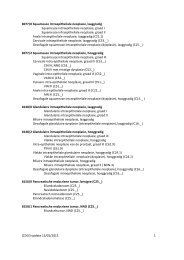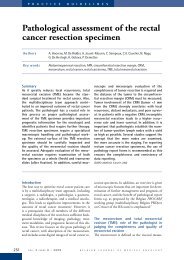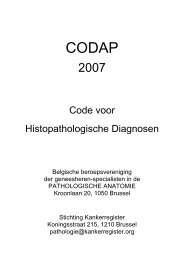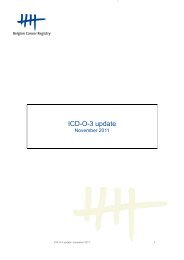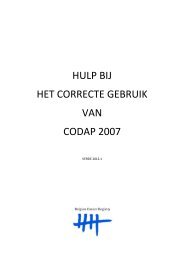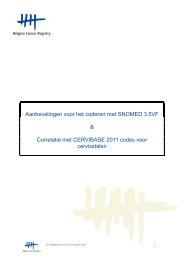Assurance de qualité pour le cancer rectal – phase 2 ...
Assurance de qualité pour le cancer rectal – phase 2 ...
Assurance de qualité pour le cancer rectal – phase 2 ...
Create successful ePaper yourself
Turn your PDF publications into a flip-book with our unique Google optimized e-Paper software.
KCE Reports 81 PROCARE <strong>–</strong> <strong>phase</strong> 2 2113977 of these hospitalisations have been coup<strong>le</strong>d between the MFD and MCDdatabases. In the MCD database information is availab<strong>le</strong> on 14467 hospitalisations of4569 patients in the cohort (64.6%). This percentage can be explained by the fact thatthe cohort inclu<strong>de</strong>s patients with an inci<strong>de</strong>nce date between January 2000 andDecember 2004, whereas the MCD and MFD databases only cover the period betweenJuly 2001 and December 2004. Moreover, it is not exclu<strong>de</strong>d that, due to thecomp<strong>le</strong>xity of i<strong>de</strong>ntification in the MCD and MFD databases, some records could not belinked between the BCR and MCD <strong>–</strong> MFD databases.It is impossib<strong>le</strong> to se<strong>le</strong>ct comp<strong>le</strong>mentary cases from the MCD-MFD database, as thepatient ID used in these databases can change from one year to another and from onecentre to another for the same patient.Above this, exclusively using the information from the MCD-MFD database (whichwould be the case for these comp<strong>le</strong>mentary patients) is insufficient to calculate any ofthe se<strong>le</strong>cted QI.In the final cohort of 7074 patients, a similar gen<strong>de</strong>r distribution can be found as in thePROCARE cohort (Tab<strong>le</strong> 1). More than 78% of patients is ol<strong>de</strong>r than 60 years. Ascompared to the prospective cohort, there is a c<strong>le</strong>ar shift towards ol<strong>de</strong>r age categoriesin the administrative cohort (Chi-Square 53.3208, p < 0.0001). Mean age is 69 years (SD12).For 5986 patients (85%) it was possib<strong>le</strong> to i<strong>de</strong>ntify the hospital where the treatment(related to <strong>rectal</strong> <strong>cancer</strong>) was given. In total, 126 hospitals are involved. The mediannumber of <strong>rectal</strong> <strong>cancer</strong> patients per hospital was 38 (range 1 <strong>–</strong> 374). Thirty-eighthospitals had <strong>le</strong>ss than 20 <strong>rectal</strong> <strong>cancer</strong> patients, whi<strong>le</strong> 12 hospitals had more than 100<strong>rectal</strong> <strong>cancer</strong> patients. For a minority of patients it was impossib<strong>le</strong> to i<strong>de</strong>ntify thehospital of treatment because no treatment was given (9%), the hospital was unknown(5%), or no information was availab<strong>le</strong> on treatment (1%).For an important proportion of patients the clinical stage is unknown (Tab<strong>le</strong> 2). This isdue to an important un<strong>de</strong>rregistration of this variab<strong>le</strong> before 2003. Since theintroduction of the multidisciplinary consultation, the registration of this variab<strong>le</strong> isobligatory for the <strong>cancer</strong> registration. Of the patients with a known clinical stage, 31%has cStage III, which is significantly lower than in the prospective cohort (Chi-Square75.9994, p < 0.0001) (Tab<strong>le</strong> 2). A higher proportion of patients of the administrativecohort have cStage IV. The relative un<strong>de</strong>rrepresentation of cStage IV patients in theprospective cohort is due to the fact that the PROCARE registration originally was asurgeon-driven initiative. Initially, and until recently, mainly cStage IV patientsun<strong>de</strong>rgoing radical resection (with or without metastasectomy) were registered bysurgeons. Since it is a voluntary registration, the clinician <strong>de</strong>ci<strong>de</strong>s which patients areinclu<strong>de</strong>d.In comparison to the prospective cohort, a small number of patients receivedneoadjuvant treatment (Tab<strong>le</strong> 3). More specifically, 55% and 70% of the cStage II and IIIpatients were treated with neoadjuvant treatment. Sixteen percent of patients was nottreated with surgery, whi<strong>le</strong> 29% was exclusively treated with surgery (Tab<strong>le</strong> 4). As forthe prospective cohort, there is a c<strong>le</strong>ar shift towards lower stages from cStage to(y)pStage, although this shift is <strong>le</strong>ss pronounced. The same remarks as for Tab<strong>le</strong> 5should be taken into account for the interpretation of Tab<strong>le</strong> 6.Tab<strong>le</strong> 6. Relation cStage - (y)pStage in the administrative cohort.(y)pStagecStage 0 I II III IV X Total0 0 7 3 0 0 0 10I 0 214 51 46 4 131 446II 0 87 276 122 14 302 801III 0 64 133 221 14 381 813IV 0 6 26 93 151 291 567X 0 514 703 612 169 2439 4437Total 0 892 1192 1094 352 3544 7074



